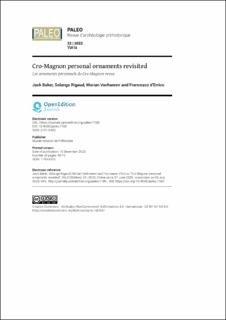| dc.description.abstract | The Cro-Magnon rock-shelter hosted the first discovered and certainly one of the most important Gravettian burial sites in Europe. However, the copious ornament collection found among the human skeletons was not analysed with modern techniques. After proposing a synthesis of the complex curatorial history of the Cro-Magnon material, we submitted a large proportion of the personal ornaments found at the site, hosted in five conservation institutions, to a taxonomic study as well as to taphonomic, morphometric and microscopic analyses. The studied assemblage encompasses shell beads belonging to six species (L. littorea, N. lapillus, Turritella sp., L. obtusata, L. lurida, C. jeffreysianus), two perforated teeth - a Red Deer canine and a bovid incisor - and three shaped pendants, two made of ivory and one displaying no diagnostic features allowing a clear identification of the raw material. Shell ornaments were compared to modern reference collections to identify selection criteria. The Cro-Magnon people used marine shells coming from both the Atlantic and possibly the Mediterranean coasts as ornaments. The distance to these coasts indicates that shells may have been acquired via exchange or during seasonal migration. Very few may have originated from closer fossil outcrops. Conversely, ivory and teeth were available locally. No size preference is observed in the L. littorea, the most represented shell species used as beads. The vast majority of shell beads were perforated by puncturing them through the aperture. All ornaments bear diagnostic traces indicating that they were worn during the individuals’ lives, and suggesting they belong to beadwork buried with the deceased. The three shaped pendants feature differences in technology, shape, size and decoration suggesting different agency for each. Re-examination of the single radiocarbon age obtained from one of the L. littorea leads us to propose, in the light of more up-to-date calibration curves and the nature of the sample, that additional radiocarbon dating should be performed in order to refine the chronological attribution of the Cro-Magnon burials. | en_US |

